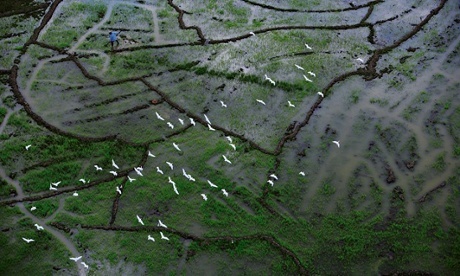COLOMBIA NEWS (The Guardian) — Colombia’s rice farmers were already struggling with climate change and unfair trade rules when they received an unlikely recommendation based on research from one of the winners of the UN Big Data Climate Challenge: “Don’t plant in this sowing season.” The advice came from Fedearroz, the main organisation for rice growers in the country, and helped 170 farmers in Córdoba avoid economic losses of an estimated $3.6m (£2.2m).

Scientists at the International Center for Tropical Agriculture (Ciat) had forecast that the first growing season of the year would coincide with a severe dry period and an acute water deficit. They urged farmers in the Caribbean department of Córdoba, one of the country’s five rice producing areas, to sow immediately to avoid an estimated yield decline of 3% for each week without sowing, but Fedearroz talked to farmers and recommended that they did not sow at all in the first growing season.
Growers in Córdoba heeded the advice and left 1,800 hectares (4,448 acres) unplanted. It saved many from potential ruin; their neighbours who did sow paid a heavy price.
The information came as the result of case studies carried out by agricultural geographer Andy Jarvis and his colleagues at Ciat using the climate-smart, site-specific agriculture decision-making tool for which it won the UN challenge.
Óscar Pérez, a rice grower who benefited from the information, believes he has been “saved” despite having missed a harvest. “We have to earn [the amount needed for] the year with the second semester harvest, which is generally better in yields and prices,” he said. Pérez plants 120 hectares of rice in Córdoba, where he employs 10 labourers, and maize and cotton in another 400 hectares.
The Ciat team used data-mining techniques to analyse information from annual rice surveys, harvest monitoring data and experiments on rice sowing dates provided by Fedearroz as well as weather data from the national institute of hydrology, meteorology and environmental studies.
Jarvis, who says up to half of the variability in rice yields can be attributed to the changing climate, said the researchers had “looked for relations between yields and climate” in two areas: Córdoba and the central department of Meta. As well as forecasting a drought, the team recommended the adoption of rice varieties that were less sensitive to sunlight.
MDG : Rice in Colombia : farmer in a flooded rice plantation, Monteria A flock of egrets above a flooded rice plantation in Monteria, Colombia. Photograph: Bobby Haas/NG/Getty Images
National yields in Colombia have been hit hard by climate change. Rice has declined from six to five tonnes per hectare in the past five years, says Patricia Guzmán, Fedearroz’s technical manager. “Weather changes are strong and highly different in every rice region and season,” she said.
The case studies are part of a two-year agreement between the ministry of agriculture and Ciat to implement a programme to help farmers adapt based on statistical work to obtain modelling and weather forecasts for rice, cassava, beans, maize and potato.

Scientists started with rice because it is the staple food most consumed, particularly among poor people, who make up 30% of the population (pdf), according to national statistics agency Dane. Chronic malnutrition (affects 13% of Colombian children under five (up to 17% in rural areas), while 27% of those children (more than 30% in rural areas) suffer from anaemia, according to the government.
But rice is expensive to grow in Colombia and many small-scale and subsistence farmers cannot compete with imports from the US, Peru and Ecuador, not to mention contraband from those countries and from Venezuela, which heavily subsidises the rice it imports. Colombia produces 2.2m tonnes per year, while smuggled rice amounts to 300,000 tonnes, Fedearroz says.
Sometimes, south-east Asian rice ends up on Colombian tables, says Miguel Gordillo Hernández, co-ordinator of Tolima’s Salvación Agropecuaria (Agricultural Salvation), a group organising peasants to combat policies that open the local food market to the world.
According to the 2012 free trade agreement (FTA) with the US, about 50,000 tonnes of US tax-free rice enters the country every year. Over this quota, the subsidised US rice is charged with an import tariff of 80%, to be phased out over a period of 19 years.
Rice is highly vulnerable to the FTA, says Gordillo Hernández. Machinery, pesticides and fertilisers are imported and costly, while a local oligopoly of rice mills until recently controlled domestic prices by running the existing laboratories to analyse quality, a key factor in fixing the price farmers get for their crop.
These problems and the difficult weather conditions put immense pressure on growers, who joined nationwide protests against the government last year. In subsequent negotiations, the government agreed to establish a reference laboratory to measure quality, ending the advantage of the mills in forming prices. It also devised a storage subsidy that the mills have to transfer to growers.
Both measures have slightly improved rice prices for growers, which are 5-8% above production costs, Gordillo Hernández says. The government has also promised to eliminate import tariffs on agricultural inputs, such as fertilisers and machinery.
But farmers are demanding public investments in technology and irrigation, debt alleviation, a crackdown on smuggled goods and renegotiation of FTAs. Otherwise, they argue, the future for rice growing in Colombia will be bleak.
“Colombia is already importing 9m tonnes of food. The day will come when all the food will be imported,” Gordillo Hernández warns.
